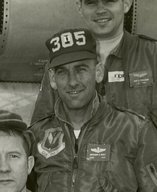
|

|
|
|
|
Anthony was born in Shreveport as the youngest of three children to Charles Redmond and Mary Elizabeth Looney Redmond. His sister was Marie Isabel Wolf Butler, his brother Charles Redmond Wolf, Jr. Their father, who worked for Arkansas Louisiana Gas Company, served in both world wars and in the reserves, retiring as a lieutenant colonel. "I knew what I was going to do when I was ten years old," he remarks about his future military career. His father was stationed at Esler (later England) Air Base in Alexandria during World War II. While his older brother served in France, Anthony stayed glued to the radio, soaking up the war news. He also worked hard: for the post office during Christmas, at clothing stores in downtown Shreveport, and for Big Chain Grocery Store. He hunted and fished with his father. The family went on trips in the family automobile, a Chevrolet, traveling to Arkansas and Missouri, including St. Louis to visit his mother's relatives. Anthony graduated from C.E. Byrd High School in 1949, entered Centenary College then transferred to Louisiana Tech where he enrolled in air force ROTC. He rode the train to Ruston, but often hitchhiked home. Anthony graduated from Louisiana Tech in 1953 and on August 29, 1953, he married Marolyn Holland. They would have five children, 11 grandchildren, and two great-grandchildren. Anthony trained as a navigator at Ellington Air Force Base in Houston, then was sent to Waco for advanced training in bombardment, where he earned his navigator wings. He was then sent to Bangor, Maine as radar navigator in an air-refueling wing of KB-29s. Nine months later the unit moved to Austin, Texas, where he was slated for service in B-47s, his first time in jets. He was sent to Mather Air Force Base near Sacramento, California. By 1956 he was in Lake Charles where he remained until 1961. Back at Mather Air Force Base he trained in the B-58, then was sent to Carswell Air Force Base and became part of the 305th Bomb Wing. "A wonderful airplane," he calls the B-58. "It was way ahead of its time because we didn't have anything like it. It was the first supersonic bomber." The jet flew at 30,000 to 45,000 feet altitude. At McConnell Air Force Base in Wichita Kansas he served as instructor in B-47 school. By then he was a captain. In 1967 at Barksdale Air Force Base in Bossier City, Louisiana he flew in the B-58 and qualified for the FB-111. Perhaps his proudest moment was participating in the fly-over at the retirement ceremony of General Curtis LeMay. "We had planes in front of us. We had planes behind us. They were everywhere. Every airplane the air force had flown was in that fly over, " he recalls. He still has the map for that flight. In all, Anthony accumulated nearly 4,000 hours in the B-58., with about "a thousand or so" in the B-47. In 1968 he began flying in the FB-111. "I loved the 111 because I could see out of it," he remarks. From Barksdale he pulled TDY (temporary duty) for a year at Carswell Air Force base training the initial cadre of crews for the FB-111. Anthony had not been stationed overseas, other than "tons of times overseas TDY", he recalls. He applied and was sent to Utapao Air Base in Thailand in August of 1973, just as the Vietnam War, with American involvement, was ending. He was sent to Bomber Operations where crews are briefed and missions set up. He soon was serving as chief of Bomber Ops. "But when I got there the war for all practical purposes was done. There was no bombing. The missions that were flown were so-called peacetime missions," he recalls. Upon returning from Thailand, Anthony retired as a lieutenant colonel at Barksdale in 1974 after 21 years of service. He returned to Lousiana Tech and earned a degree in education and a master's degree in counseling. He taught school three years, then began land work as a petroleum land man for 29 years. When he began, mineral rights were about $75 to $100 an acre. Prices have soared, he says, to prices such as $16,000 an acre. Over the years, he has remained in contact with his crew, including navigator Jack Ferguson and pilot Bob Robinson. |


